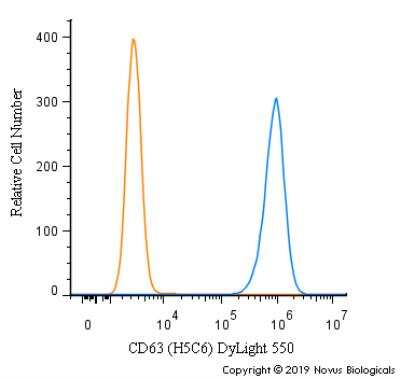CD63 Antibody (H5C6) [DyLight 550]
Novus Biologicals, part of Bio-Techne | Catalog # NBP2-42225R
Clone H5C6 was used by HLDA to establish CD designation.


Conjugate
Catalog #
Key Product Details
Species Reactivity
Human, Canine
Applications
Block/Neutralize, Dot Blot, Electron Microscopy, ELISA, Flow (Intracellular), Flow Cytometry, Functional, Immunocytochemistry/ Immunofluorescence, Immunohistochemistry Whole-Mount, Immunoprecipitation, In vitro assay, Western Blot
Label
DyLight 550 (Excitation = 562 nm, Emission = 576 nm)
Antibody Source
Monoclonal Mouse IgG1 kappa Clone # H5C6
Concentration
Please see the vial label for concentration. If unlisted please contact technical services.
Product Specifications
Immunogen
Human splenic adherent cells.
Marker
Exosome Marker
Clonality
Monoclonal
Host
Mouse
Isotype
IgG1 kappa
Scientific Data Images for CD63 Antibody (H5C6) [DyLight 550]
Immunocytochemistry/Immunofluorescence: CD63 Antibody (H5C6) [DyLight 550] [NBP2-42225R] - HeLa cells were fixed in 4% paraformaldehyde for 10 minutes and permeabilized in 0.05% Triton X-100 in PBS for 5 minutes. The cells were incubated with anti-CD63 Antibody [H5C6] conjugated to DyLight 550 (NBP2-42225R) at 5 ug/ml for 1 hour at room temperature. Nuclei were counterstained with DAPI (Blue). Cells were imaged using a 100X objective and digitally deconvolved.
Flow Cytometry: CD63 Antibody (H5C6) [DyLight 550] [NBP2-42225R] - An intracellular stain was performed on SK-MEL-28 cells with CD63 (H5C6) Antibody NBP2-42225R (blue) and a matched isotype control (orange). Cells were fixed with 4% PFA and then permeabilized with 0.1% saponin. Cells were incubated in an antibody dilution of 5 ug/mL for 30 minutes at room temperature. Both antibodies were conjugated to DyLight 550.
CD63 (H5C6) in A431 Human Cell Line -
CD63 (H5C6) was detected in immersion fixed A431 human skin carcinoma cell line using Mouse anti-CD63 (H5C6) Protein-G purified Monoclonal Antibody conjugated to DyLight 550 (Catalog # NBP2-42225R) (red) at 5 µg/mL overnight at 4C. Cells were counterstained with DAPI (blue). Cells were imaged using a 100X objective and digitally deconvolved.Applications for CD63 Antibody (H5C6) [DyLight 550]
Application
Recommended Usage
Block/Neutralize
Optimal dilutions of this antibody should be experimentally determined.
Dot Blot
Optimal dilutions of this antibody should be experimentally determined.
ELISA
Optimal dilutions of this antibody should be experimentally determined.
Electron Microscopy
Optimal dilutions of this antibody should be experimentally determined.
Flow (Intracellular)
Optimal dilutions of this antibody should be experimentally determined.
Flow Cytometry
Optimal dilutions of this antibody should be experimentally determined.
Functional
Optimal dilutions of this antibody should be experimentally determined.
Immunocytochemistry/ Immunofluorescence
Optimal dilutions of this antibody should be experimentally determined.
Immunohistochemistry Whole-Mount
Optimal dilutions of this antibody should be experimentally determined.
Immunoprecipitation
Optimal dilutions of this antibody should be experimentally determined.
In vitro assay
Optimal dilutions of this antibody should be experimentally determined.
Western Blot
Optimal dilutions of this antibody should be experimentally determined.
Application Notes
Optimal dilution of this antibody should be experimentally determined.
Formulation, Preparation, and Storage
Purification
Protein G purified
Formulation
50mM Sodium Borate
Preservative
0.05% Sodium Azide
Concentration
Please see the vial label for concentration. If unlisted please contact technical services.
Shipping
The product is shipped with polar packs. Upon receipt, store it immediately at the temperature recommended below.
Stability & Storage
Store at 4C in the dark.
Background: CD63
References
1. Pols, M. S., & Klumperman, J. (2009). Trafficking and function of the tetraspanin CD63. Experimental cell research. https://doi.org/10.1016/j.yexcr.2008.09.020
2. Metzelaar, M. J., Wijngaard, P. L., Peters, P. J., Sixma, J. J., Nieuwenhuis, H. K., & Clevers, H. C. (1991). CD63 antigen. A novel lysosomal membrane glycoprotein, cloned by a screening procedure for intracellular antigens in eukaryotic cells. The Journal of biological chemistry.
3. Horejsi, V., & Vlcek, C. (1991). Novel structurally distinct family of leucocyte surface glycoproteins including CD9, CD37, CD53 and CD63. FEBS letters. https://doi.org/10.1016/0014-5793(91)80988-f
4. Eckfeld, C., HauBler, D., Schoeps, B., Hermann, C. D., & Kruger, A. (2019). Functional disparities within the TIMP family in cancer: hints from molecular divergence. Cancer metastasis reviews. https://doi.org/10.1007/s10555-019-09812-6
5. Hoffmann, H. J., Santos, A. F., Mayorga, C., Nopp, A., Eberlein, B., Ferrer, M., Rouzaire, P., Ebo, D. G., Sabato, V., Sanz, M. L., Pecaric-Petkovic, T., Patil, S. U., Hausmann, O. V., Shreffler, W. G., Korosec, P., & Knol, E. F. (2015). The clinical utility of basophil activation testing in diagnosis and monitoring of allergic disease. Allergy. https://doi.org/10.1111/all.12698
6. Dell'Angelica, E. C., Shotelersuk, V., Aguilar, R. C., Gahl, W. A., & Bonifacino, J. S. (1999). Altered trafficking of lysosomal proteins in Hermansky-Pudlak syndrome due to mutations in the beta 3A subunit of the AP-3 adaptor. Molecular cell. https://doi.org/10.1016/s1097-2765(00)80170-7
Alternate Names
CD63, Granulophysin, Lamp-3, ME491, OMA81H, Tspan30
Gene Symbol
CD63
Additional CD63 Products
Product Documents for CD63 Antibody (H5C6) [DyLight 550]
Product Specific Notices for CD63 Antibody (H5C6) [DyLight 550]
DyLight (R) is a trademark of Thermo Fisher Scientific Inc. and its subsidiaries.
This product is for research use only and is not approved for use in humans or in clinical diagnosis. Primary Antibodies are guaranteed for 1 year from date of receipt.
Loading...
Loading...
Loading...
Loading...
Loading...
Loading...

![CD63 (H5C6) in A431 Human Cell Line - CD63 Antibody (H5C6) [DyLight 550]](https://resources.bio-techne.com/images/products/nbp2-42225r_mouse-monoclonal-cd63-antibody-h5c6-dylight-550-immunocytochemistry-immunofluorescence-143202414923..jpg)
![Detection of CD63 (H5C6) in A431 Human Cell Line by Flow Cytometry. CD63 Antibody (H5C6) [DyLight 550]](https://resources.bio-techne.com/images/products/nbp2-42225r_mouse-monoclonal-cd63-antibody-h5c6-dylight-550-flow-intracellular--3092024154326..jpg)